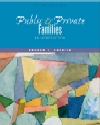EXERCISE 1 The U.S. Bureau of the Census collects detailed statistics through its monthly Current Population Survey, its Decennial Census of Population, and other studies. The information in this chapter on the growth of racial and ethnic minority families, household composition, and interracial families was obtained from the treasure trove of information at the Census Bureau's home page, www.census.gov. For instance, to find out the latest information on Hispanic families, select "H" in the "Subjects A to Z" box; then, on the next screen, find "Hispanic" and select the subcategory "People." You can then select and view the latest annual report on the Hispanic population in the United States. What percentage of the Hispanic population is now of Mexican origin? EXERCISE 2 The National Academy of Sciences convenes panels of experts to address scientific issues. Many of the panels publish their reports as books through the National Academy Press. Recently, the National Academy Press put the complete text of hundreds of these reports on-line at its web site, www.nap.edu. There you can read the report of the panel on the new second generation of immigrant children, From Generation to Generation (Hernandez & Charney, 1998). Go to the web page and then enter the title in the title-search box. When you have found the title, click on the "Open book, searchable, READ" button; you should see the table of contents. This report contains a number of tables on the conditions of immigrant children. Select Appendix B and examine the first table (starting on page 21), which shows the percentage of first- and second-generation children who are poor, by country of origin. Which country has the highest percentage of poor immigrant children? Which has the lowest? EXERCISE 3 - The Changing Ethnic Pie Visit the Ameristat site at http://www.ameristat.org. and click on Race and Ethnicity in the menu. Then click on The Changing American Pie. Which groups are expected to grow fastest? Where will this growth primarily occur? From your reading of the data, what are the biggest challenges that the US faces in the future relative to changing ethnic distribution of the population? EXERCISE 4 - Intercultural Adoption Many American families are adopting children from other countries. Several organizations have been established to assist and support (and profit from) these families. See an example, Children's Hope, at http://www.childrenshopeint.org/. Browse the site and see how they frame the process. What kinds of countries and children are in the system? What is the cost to the adoptive parent? What kind of support is offered? See also a typical magazine for the international adoption market: http://www.redthreadmag.com/. |



 2002 McGraw-Hill Higher Education
2002 McGraw-Hill Higher Education